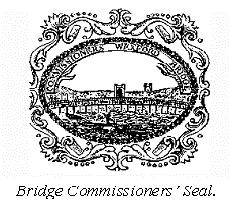WEXFORD TOWN TOPOGRAPHY
The town is situated on the lower part of a hill, close to the shore of the estuary of the Slaney, where it opens into the broad but shallow expansion of Wexford haven. Its extent from north to south within the walls is nearly a statute mile, or a mile and a quarter, including the suburb of Faithe at its southern extremity, the name of which is a corruption of Feagh, from the parish of St. Michael of Feagh, in which it is situated. The streets are narrow, partially and indifferently paved, and not lighted; two attempts, made in 1830 and 1833, to bring the town within the provisions of the act of the 9th of George IV., for paving, lighting, and cleansing towns, failed; the proposal being each time rejected by a majority of a public meeting convened for its consideration. An arrangement recently made with a Scotch contractor to light the quay with gas will probably remove this inconvenience, by having the contract extended to the rest of the town. It contains 1820 houses, in general well built and of respectable appearance; the supply of water is partly by pipes laid down by the corporation for improving the quays, and partly from wells, or from the public conduit in the corn-market, erected at the expense of the Marquess of Ely.
The town is connected at its northern end with the grounds on the opposite bank of the Slaney by a bridge commenced in 1794, and opened in 1795; it was constructed wholly of American oak, at an expense of £17,000, by the late Emanuel Cox, an engineer from the United States, and the builder of the wooden bridge at Londonderry: its length was 1571 feet. The collection of the tolls and care of the bridge was committed to a corporation, consisting of the shareholders who contributed towards its erection and some ex-officio members. In consequence of its decayed state the corporation had it repaired, or rather re-constructed, at an expense of £6000, of which £4000 was raised by a mortgage of the tolls, which let, in 1832, for £700 per annum.
The collection of the tolls and care of the bridge was committed to a corporation, consisting of the shareholders who contributed towards its erection and some ex-officio members. In consequence of its decayed state the corporation had it repaired, or rather re-constructed, at an expense of £6000, of which £4000 was raised by a mortgage of the tolls, which let, in 1832, for £700 per annum.
The structure now consists of two causeways projecting from the opposite banks of the river, and of the respective lengths of 650 and 188 feet; the roadway of the bridge over the intervening space of 733 feet is of timber, supported on 23 sets of piers of the same material, with a drawbridge, to permit the passage of vessels with masts.
A quay extends for nearly half a mile from the bridge, having a general breadth of 60 feet, except near its middle, called the Crescent, where it widens to 80 feet. On the opposite shore has been raised the ballast quay, so called from being formed by the ballast deposited there by the shipping: it serves as a breakwater for the protection of the vessels moored on the side towards the town. The former of these quays has received a considerable extension to the south-west by an embankment raised by J. E. Redmond, Esq., which carries it on in a direct line to the end of Fishers'-row, whence a communication with that part of the country will be opened by a road in the same direction to the rock of Maudlintown, where it will form a junction with the Killinick road.
A branch of the Bank of Ireland occupies a very neat structure faced with granite, forming the northwestern angle of the Crescent. The Provincial Bank has also an establishment on the quay. A building, with an exterior corresponding with that of the Bank, is about to be erected on the Crescent-quay, for reading-rooms and a library; on the same quay a building is also in progress for the accommodation of the Chamber of Commerce, established in 1831; two reading-rooms have been already opened.
The Wexford Union Club, formed in 1833, is held in a building erected for it on the quay. A small and neat theatre was built in the Back-street about four years since, as a private speculation, which not having succeeded, it is used as an auction and commission sale-room, without any alteration in its internal arrangements: a circulating library is kept in its lobby. Balls for public charities and on other occasions are given in the Assembly-rooms, a handsome suite of apartments belonging to the corporation.
The castle and its surrounding grounds, granted by Cromwell to a person named Borr, were sold about a century since to the Government by that individual's representative, who contracted to convert it into a spacious barrack; but the transaction having been made the subject of parliamentary inquiry, the contractor, who was a member of the House of Commons, was obliged to vacate his seat and the treaty was put an end to. The present barracks, situated at the commencement of the Faithe, form a considerable range, capable of affording accommodation to 7 officers and 172 men, with an hospital for 12 patients. Several new streets have been opened within the last few years.
County Wexford | Wexford Town | Wexford Town Topography | Wexford Town Manufacturing | Wexford Port | Wexford Charter | Wexford Union | Wexford Schools | Wexford Town Antiquities
